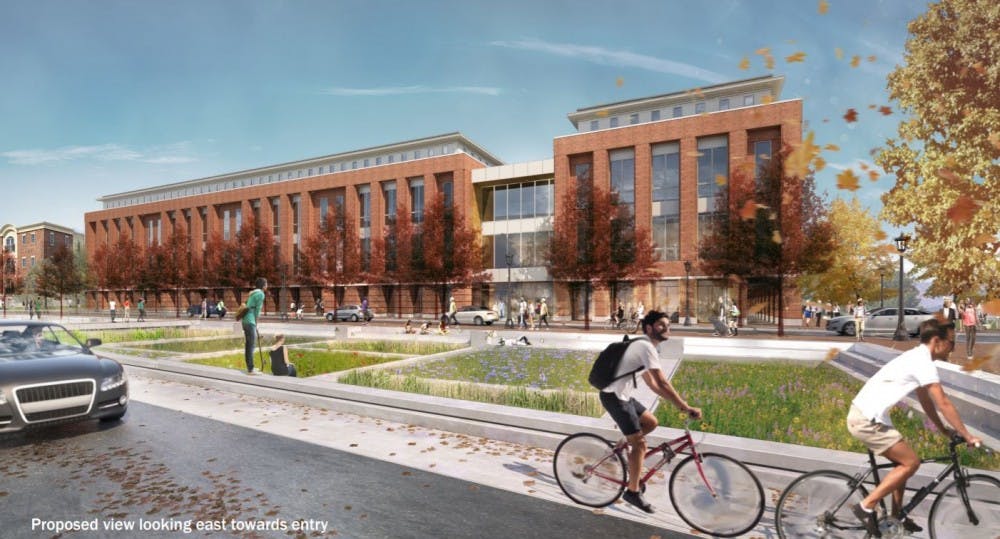As part of the University Advancement’s Office of Engagement's Lifetime Learning initiative, Architect for the University Alice Raucher updated attendees on ongoing projects that the Office of the Architect is overseeing on-Grounds at an event held in Newcomb Theatre Saturday.
Raucher detailed the ongoing construction on Brandon Avenue, which includes the construction of a new Student Health Center. In September, alumni Robert and Molly Hardie donated $1 million to the construction of the new Student Health Center, which will replace the current Elson Student Health Center. There was another $1 million donation in June — that money was donated anonymously.
In her presentation, Raucher stated that the new Student Health Center will be “much more focused on student wellness and education,” featuring a teaching kitchen, study spaces and social spaces for students who might not want to travel all the way to the Corner.
Raucher also stated they designed the building with the idea of “biophilia” in mind — meaning that people have an innate need for “a connection to the outdoors.” Because of this, the building was designed to have lots of sunlight and access to the exterior.
According to Raucher, the new Student Health Center is planned to open in early 2021.
Raucher also went into detail describing the ongoing changes to the Emmet-Ivy Corridor, which will feature the new School of Data Science, as well as a new hotel and conference center.
Raucher described three “nexuses” that will develop in this area — a Democracy Nexus, a Creativity and Experimental Arts Nexus and a Discovery Nexus.
The School of Data Science will be located in the Discovery Nexus, Raucher said. The Creativity Nexus will, if enough philanthropic support occurs, feature a new performing arts center. Currently, Old Cabell Hall hosts University arts programs, but University Vice Provost for the Arts Jody Kielbasa told The Cavalier Daily in March that the building lacks the resources of a performing arts center. Additionally, the Democracy Nexus may end up being the location of the Batten School.
According to the University’s Master Plan, the nexuses are “designed to encourage cross-disciplinary endeavors involving people from across Grounds and beyond, in an active and engaging environment.”
An increase to pedestrian friendliness in both the Emmet-Ivy Corridor and the Athletics area was emphasized throughout Raucher’s presentation. She described the Emmet-Ivy Corridor as being “pedestrian-focused,” with an emphasis on having a bustling, multipurpose area for students and the community.
“We're hoping that it will have a variety of different uses, restaurants, cafes, study spaces and maker spaces that make that ground floor very transparent and very busy,” Raucher said.
Raucher also revealed that the University worked with the City of Charlottesville to secure $12.1 million in funding to improve pedestrian and bike safety, along with traffic and pedestrian improvements, at the Emmet-Ivy intersection.
The construction of an “Athletics Promenade” was also discussed.
“Now, when you cross Goodwin Bridge you have to weave your way down through all these parking lots … it's not an ideal situation for our students or any pedestrians frankly,” Raucher said.
The proposed Athletics Promenade begins at the east side of the Goodwin Bridge and continues through the Olympic Sports Center, McCue Center and practice fields before moving alongside the Softball Stadium and Klockner Stadium to connect to North Grounds.
Images were also shared of ongoing construction at the new Softball Stadium, which will open in March, marking the 40th anniversary of softball at the University.
Raucher also described the design process for the Memorial to Enslaved Laborers, which will be opened to the public and dedicated April 11.
“The memorial itself encompasses the idea of clearing a gathering space, and also utilizes water as a symbolic idea of rebirth as part of the memorial,” Raucher said. “And the form itself is based upon the broken shackle of the slave as well as the more joyful ring shout.”
Raucher revealed that the two paths that will run parallel to the memorial have significance. One lines up with the North Star, which enslaved laborers followed towards freedom in the North, while the other lines up with the sunset on Liberation Day, which Charlottesville celebrates March 3 to commemorate the emancipation of enslaved residents of the City of Charlottesville and Albemarle County.
The Memorial to Enslaved Laborers will be part of the ritual walk that occurs on Liberation Day.
Correction: This article previously attributed the Lifetime Learning initiative to the Alumni Association. It has been updated to reflect that it is a part of the University Advancement’s Office of Engagement.







